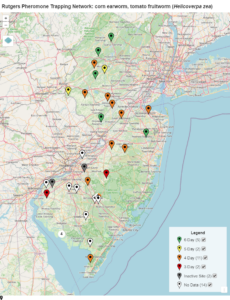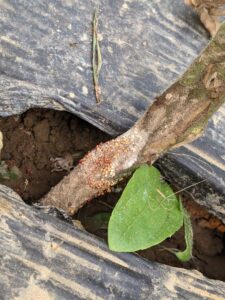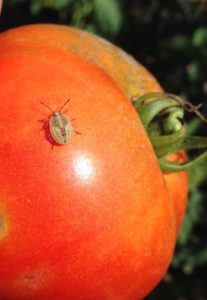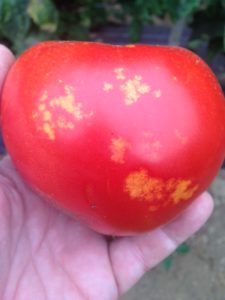Sweet Corn
Fall Armyworm Alert!
Fall armyworm (FAW) infestations are increasing in frequency and severity now. While numbers are not extreme, field scouts are reporting infestation rates from 12-30% with some regularity in many parts of central and northern NJ. Cooperating growers in Cape May County (where FAW is typically heaviest) report that FAW is now present in whorl and pre-tassel stage plantings. Because FAW moths are highly mobile, and with southerly winds continuing to dominate, it is important to monitor fields at least weekly for signs of infestation. Whorl stage plants are prime targets for egg laying.
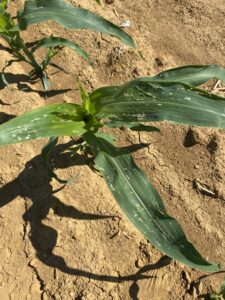 Newly hatched FAW larvae cause holes and scratches on leaves that are similar to ECB feeding, except that they tend to be more concentrated and always lead down into the whorl (see photo at left). As the larvae grow, the feeding becomes more destructive, with large ragged holes and obvious droppings deposited in the whorl (see photo at right).
Newly hatched FAW larvae cause holes and scratches on leaves that are similar to ECB feeding, except that they tend to be more concentrated and always lead down into the whorl (see photo at left). As the larvae grow, the feeding becomes more destructive, with large ragged holes and obvious droppings deposited in the whorl (see photo at right). 
We will provide updates on new FAW appearances and severity as reports come in. FAW are resistant to synthetic pyrethroids. Effective sprays should include IRAC grp. 5 (spinosyns) or IRAC grp. 28 (diamides). The carbamate (IRAC grp. 1A) Lannate is also still effective. Sufficient water should be used in the applications to allow the solution to penetrate the layer of droppings that may have formed above the caterpillar.
Corn earworm (CEW) moths captures from northern and central blacklight traps have remained fairly stable, with some traps experiencing low level catches and others none. Pheromone trap information is available from all northern and central sites, but is limited this week from southern New Jersey. Overall, pheromone catches remain modest, but with shifting areas of higher activity. Tabernacle (Burlington) and Woodstown (Salem) remain higher catching sites, but Hackettstown (Warren) has also seen a dramatic increase in catch. Most pheromone traps registered a fairly low population of moths (see pheromone trap may below). We should expect incremental increases through early August. Large migratory populations can occur here any time that weather turns favorable for long range moth movement in August. We will use a combination of pheromone and blacklight trap types to derive silk spray schedules by region. Silking corn is at risk of CEW infestation at this time. Be sure to access information from this publication in the upcoming weeks to determine how frequently you should treat silking sweet corn to protect it from CEW infestation.
The highest nightly blacklight trap catches of CEW for the week ending 7/24/24 are as follows:
| Denville 2 | Blairstown 1 | Lawrenceville 1 | Port Murray 1 |
| Flanders 2 | Chester 1 | Matawan 1 | |
| Allamuchy 1 | Georgetown 1 | Morristown 1 |
The highest nightly pheromone trap catches of CEW for the week ending 7/24/24 are as follows:
| Tabernacle 30 | Bellemeade 16 | Snyder Farm (Hunterdon) 9 |
| Hackettstown 27 | South Branch 14 | Green Creek 7 |
| Woodstown 22 | Georgetown 12 | Matawan 6 |
| New Egypt 19 | Dayton 9 | Chester 4 |
Using our current pheromone- based thresholds (30″ Hartstack trap) developed by the Univ. of Delaware, nightly corn earworm moth catches translate to:
0 moths – 6-7 day spray schedule
1 moth – 5 day spray schedule
2-20 moths – 4 day spray schedule
>20 moths – 3 day spray schedule
Silking Spray Schedules*:
South – 3-4 days
Central – 4 days
North – 4 days
*These recommendations are based on regional catches. Adhere to tighter spray schedules if indicated by local trap catches. Synthetic pyrethroids alone should NOT be used for corn earworm (CEW) protection on silking corn, or for fall armyworm (FAW) management at any stage. Control with these materials is very inconsistent.
Growers experiencing problems with sap beetles during harvest should consider adding the active ingredient acetamiprid in 1-2 silk applications along with the CEW targeted materials. This IRAC group 4A material (Assail, Anarchy) will not control CEW, but is useful for sap beetles and corn leaf aphids. Hot days and warm nights favor sap beetle infestations, particularly when corn ears grow to the end of the husks, enabling easy entry for the beetles.
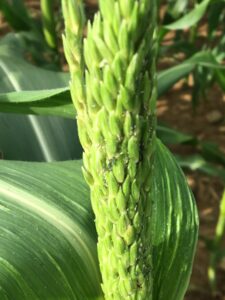 Field scouts are finding corn leaf aphid (photo at left) more often in pre-tassel and tassel stage sweet corn. This pest can build to very high numbers on plants, and with repeated use of pyrethroid insecticides, can become a contaminant as it infests corn ear husks. If aphids are detected in tassels just prior to silking, consider adding the neonicotinoid acetamiprid (Assail, Anarchy) to the regular silk spray material(s). Methomyl (Lannate) is also useful at limiting aphid populations.
Field scouts are finding corn leaf aphid (photo at left) more often in pre-tassel and tassel stage sweet corn. This pest can build to very high numbers on plants, and with repeated use of pyrethroid insecticides, can become a contaminant as it infests corn ear husks. If aphids are detected in tassels just prior to silking, consider adding the neonicotinoid acetamiprid (Assail, Anarchy) to the regular silk spray material(s). Methomyl (Lannate) is also useful at limiting aphid populations.
Tomatoes
Southern blight has been found on a few farms in the scouting program this season. This fungal disease (Sclerotium rolfsii) causes rapid wilting and death of plants. Inspection of the main stem at the soil line reveals the presence of numerous spherical structures (sclerotia) adhering to the stem (see photo at right – courtesy of Rhea Bolar). This disease was once relatively uncommon in NJ, especially in northern counties, but exceptionally hot conditions with high soil moisture are contributing to it’s appearance. Little can be done once it appears. Tomatoes, peppers and vine crops should be avoided in fields with a history of this disease. Future plantings may be treated with the PCNB fungicide, Blocker in the transplant water. See the Tomato Section of the 2024-25 Commercial Veg. Recs. for details.
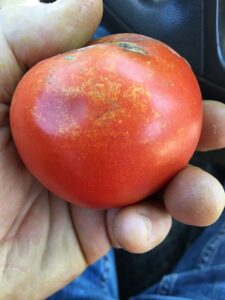 Thrips infestations continue in some high tunnels and fields. Hot weather can increase infestations. These
Thrips infestations continue in some high tunnels and fields. Hot weather can increase infestations. These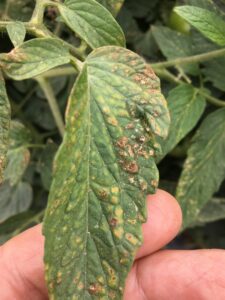 insects initially feed on foliage (see photo at right), and ultimately move to the surface of fruit, where they cause gold flecking to occur on ripening fruit (photo at left). While all “gold fleck” is not related to thrips, that which forms distinct rings and trails on fruit surfaces is caused by their feeding. Thrips can be difficult to manage due to insecticide resistance issues and their habit of hiding in blossoms and other tight spaces on the plants. It is best to apply control before populations become widespread in plantings. See the Tomato Section from the 2024-25 Guide for suggested insecticides.
insects initially feed on foliage (see photo at right), and ultimately move to the surface of fruit, where they cause gold flecking to occur on ripening fruit (photo at left). While all “gold fleck” is not related to thrips, that which forms distinct rings and trails on fruit surfaces is caused by their feeding. Thrips can be difficult to manage due to insecticide resistance issues and their habit of hiding in blossoms and other tight spaces on the plants. It is best to apply control before populations become widespread in plantings. See the Tomato Section from the 2024-25 Guide for suggested insecticides.

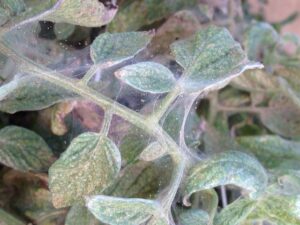 Two-spotted spider mite (TSSM) infestations are becoming more common in scouted tomato plantings. These pests multiply rapidly, and can cause severe defoliation under high temperature conditions if not detected early. Look for leaflets exhibiting pin spots (left) on the upper surface. These leaflets will become yellow as TSSM numbers increase. Mites may be observed on the underside of leaves showing these signs. Extreme infestations will result in extensive webbing being produced on top of foliage (right). Treatment should be undertaken when mites are first detected, because larger established infestations are quite difficult to control. Spot treatments may be effective if the infestation is limited. See the Tomato Section of the 2024-25 Commercial Veg. Recs. for details on effective materials.
Two-spotted spider mite (TSSM) infestations are becoming more common in scouted tomato plantings. These pests multiply rapidly, and can cause severe defoliation under high temperature conditions if not detected early. Look for leaflets exhibiting pin spots (left) on the upper surface. These leaflets will become yellow as TSSM numbers increase. Mites may be observed on the underside of leaves showing these signs. Extreme infestations will result in extensive webbing being produced on top of foliage (right). Treatment should be undertaken when mites are first detected, because larger established infestations are quite difficult to control. Spot treatments may be effective if the infestation is limited. See the Tomato Section of the 2024-25 Commercial Veg. Recs. for details on effective materials.
Native brown stink bugs area active in tomato fields. These true bugs (see photo of Euschistus sp. nymph below at left), move into irrigated tomato fields as forage in the surrounding environment dries out. Feeding results in “cloudy spot” (see photo at right below). Increases in stink bug injury are often found by crews picking the fruit, and in fact, this is happening now. Growers should consider 1-2 insecticide applications to limit fruit injury if this damage is increasing in harvested fruit. If actively scouting fields, insecticides should be considered if stink bug adults, nymphs or new fruit injury is found in 2 or more sample sites in a 10 site sample. Insecticides that are effective on stink bugs include pyrethroids and neonicotinoids (see Tomato Section from the 2024-25 Guide), so care should be taken to avoid contact with foraging bees.
Beet Armyworm
Beet armyworm (BAW) numbers in pheromone traps in the Woodstown area of Salem County have remained fairly high over the past week. Thanks to a grower cooperator in that area, we know that catches ranged from 17/night to 23/night over the past week in local traps. This pest can cause significant injury on peppers as well as leafy greens like swiss chard. Monitor pepper fields weekly for signs of feeding. BAW larvae (photo at left) feed in the developing foliage in terminal growth of plants. Initially, leaves are skeletonized, but as larvae grow, they will move onto fruit and damage these as well. Extreme injury to swiss chard and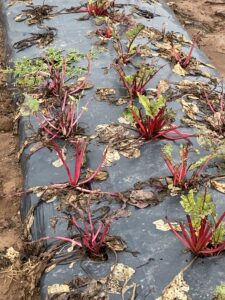
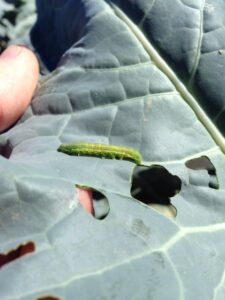 collards can occur very quickly (photo at right). In northern NJ, BAW is an occasional, and typically low level pest of cole crops. Infestations tend to be very local for unknown reasons. As with other armyworms, BAW is difficult to control with pyrethroid insecticides. Effective materials include spinosyns (IRAC 5) and diamides (IRAC 28).
collards can occur very quickly (photo at right). In northern NJ, BAW is an occasional, and typically low level pest of cole crops. Infestations tend to be very local for unknown reasons. As with other armyworms, BAW is difficult to control with pyrethroid insecticides. Effective materials include spinosyns (IRAC 5) and diamides (IRAC 28).
Cucurbit downy mildew (CDM) has been detected on cucumber in the sentinel plot at Snyder Research and Extension Farm in Pittstown, Hunterdon County as of 7/17/24. Additionally, a Morris County cooperator reports CDM on an abandoned cucumber plot near Chester. All cucumber growers should monitor fields for signs of this disease. Look for chlorotic areas bordered by veins on the upper leaf surface (photo at lower right). If conditions are moist, dark sporulation may be found on the lower leaf surface (photo at lower left).
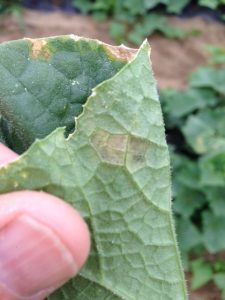
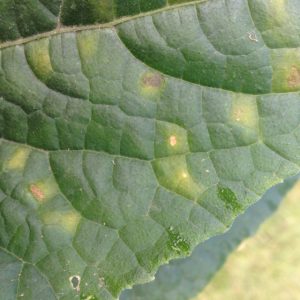 All cucumber and cantaloupe plantings should be protected. Useful materials for CDM may be found in the Cucumber Section of the 2024/25 Commercial Vegetable Production Recommendations. A sentinel plot has been established at Snyder Farm in Hunterdon County. This plot consists of pumpkin, watermelon, cantaloupe, butternut, acorn, cucumber and kabocha squash will be used to indicate the presence of cucurbit downy mildew in the region, and what crops are affected. As of 7/22/24, CDM had not been detected on any of these crops except cucumber in the sentinel plot, nor has CDM been found on any scouted field in northern and central NJ except cucumber.
All cucumber and cantaloupe plantings should be protected. Useful materials for CDM may be found in the Cucumber Section of the 2024/25 Commercial Vegetable Production Recommendations. A sentinel plot has been established at Snyder Farm in Hunterdon County. This plot consists of pumpkin, watermelon, cantaloupe, butternut, acorn, cucumber and kabocha squash will be used to indicate the presence of cucurbit downy mildew in the region, and what crops are affected. As of 7/22/24, CDM had not been detected on any of these crops except cucumber in the sentinel plot, nor has CDM been found on any scouted field in northern and central NJ except cucumber.
Thank you!
The Vegetable IPM Program wishes to thank the following Field Technicians, without whom much of the information presented weekly here would not be available:
Chris Cloutier
Hamna Khalid
Alexandra Suszko
